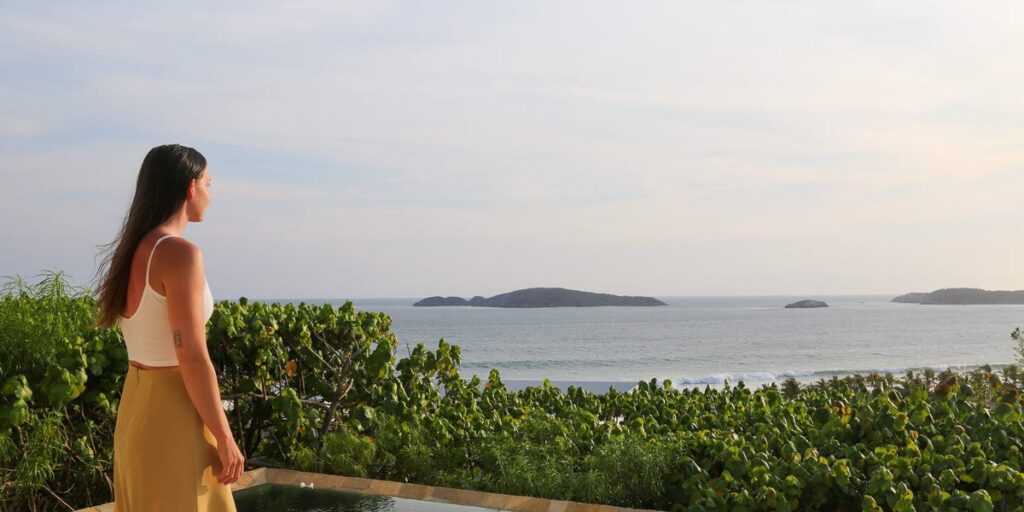I reached Mexico’s Happy Coast feeling stressed, anxious, and quite frankly, unhappy.
Upon my arrival in Puerto Vallarta, I found myself at the rental car company, utterly bewildered. After an unexpected $300 expense, I embarked on a three-hour drive along a bumpy road to my first resort in Costalegre. As I navigated behind slow mopeds and endured countless speed bumps, I couldn’t shake off the nausea from the winding roads and the scratchy throat from nearby wildfires. Was all this discomfort really worth it? I began to question how a place could earn a name like the Happy Coast when it felt so challenging to reach.
Located on Mexico’s Pacific Coast, Costalegre is a 200-mile stretch of coastline nestled between Puerto Vallarta and Manzanillo. It boasts a stunning juxtaposition of quaint seaside towns alongside multimillion-dollar resorts. For years, this region has served as a discreet retreat for the elite, attracting celebrity visitors from Mick Jagger to Bill Gates. The majority of the properties here are privately owned, developed by families committed to preserving the local ecosystems.
I spent a week traversing dirt roads, sipping margaritas with strangers, and hopping between resorts in Costalegre. Before my trip to Mexico, luxury vacation destinations were typically associated with extravagance. But Costalegre reshaped that perception for me. By the time I bid farewell to the rugged coastline, I was enthralled by this undisturbed haven where luxury is seamlessly integrated with nature.
When I mentioned my trip to friends and family, they immediately assumed I was headed to Cancún or Tulum, with not a single person knowing about Costalegre. “It’s still unknown,” said Alba Garcia, director of rooms at the Four Seasons Tamarindo, a luxury hotspot in the area. “It’s an ‘if you know, you know’ kind of vibe.”
Maria Campos, director of client services at Las Rosadas, a collection of private villas along Costalegre, revealed that growing up in the nearby town of Chamela, the coast was typically referred to as Costa Sur. In 1990, the state of Jalisco officially designated the region as a priority tourism area and named it the Costalegre Ecological Tourism Corridor.
Unlike Finland, known for being one of the happiest countries in the world, Costalegre playfully embraces its title. Most visitors don’t initially seek out Costalegre; they often stumble upon it while exploring Puerto Vallarta or through recommendations from friends. For those familiar with Costalegre, the private community of Careyes is likely the reason.
In 1968, Italian banker Gian Franco Brignone flew over Mexico’s Pacific Coast, captivated by the view from his small plane. He purchased 13,000 acres to build a vibrant retreat. Today, Careyes spans 35,000 acres, featuring a 25,000-acre biosphere, numerous luxury villas, and colorful residences.
While Careyes’ aesthetic is striking, it’s the clientele that has put it on the map. The area has hosted weddings for celebrities like Heidi Klum and Seal and has welcomed figures such as Tom Ford and Naomi Campbell.
Careyes may have been the trailblazer for luxury development in the region, but it certainly wasn’t the last. James Goldsmith, a French-British financier, later constructed a nearby luxury resort—the well-known Cuixmala. Other properties like Las Alamandas and Four Seasons Tamarindo soon followed. Currently, only a handful of upscale resorts populate this rocky coastline.
With limited options, the experience here contrasts sharply with bustling places like Cabo or Cancún, where high-rises and crowded establishments dominate. Instead, Costalegre offers tranquility and privacy. Several times during my visit, it was just my travel partner and me on an expansive beach—an experience rare in today’s world.
This sense of isolation is what draws many to the Happy Coast. “I don’t think there are too many places in the world where you can walk three kilometers down the coast and there’s no one there,” stated Viviana Dean, a Careyes resident.
However, this appeal doesn’t resonate with everyone. Kessler mentioned that the area attracts a refined clientele, one that values understated luxury and nature rather than extravagant brand names.
By the end of my trip, I reflected on what makes Costalegre special: a blend of simplicity, seclusion, and elegance. The stunning, seashell-laden beaches at Las Rosadas paired with private infinity pools created an extraordinary experience.
While the Four Seasons Tamarindo provided memorable moments in its pristine jungle, it was the warm service—like fresh pastries delivered by a concierge via text—that truly defined a five-star experience.
During a rejuvenating morning yoga session at Careyes, I listened to waves crashing while lowering into Warrior 2. As the class concluded, a conversation between a few attendees caught my attention. It epitomized the upscale vibe I expected at this luxury getaway, yet the focus remained on nature and relaxation over commercial tourism.
In nearby towns like Barra de Navidad and Melaque, the atmosphere buzzes with life, catering more to locals and regional tourists. But most affluent visitors were not drawn to venture far from their secluded resorts.
As I concluded my trip back at Puerto Vallarta International Airport, I was reintroduced to the chaos and noise of everyday life. Yet I felt calm and content.
What made Costalegre remarkable? It was not just the stunning resorts, but also the unspoiled landscapes and the friendly locals. Families like the Brignones and resort owners like Isabel Goldsmith are passionate about preserving the environment around them.
The hope is for this hidden gem to remain unspoiled, even as properties expand cautiously, maintaining the balance of luxury with nature. Moments of solitude, adorned with lavish amenities and breathtaking views, left me truly grateful for my experience in this serene oasis.


